Input interpretation

HCl hydrogen chloride + AgBr silver bromide ⟶ HBr hydrogen bromide + AgCl silver chloride
Balanced equation
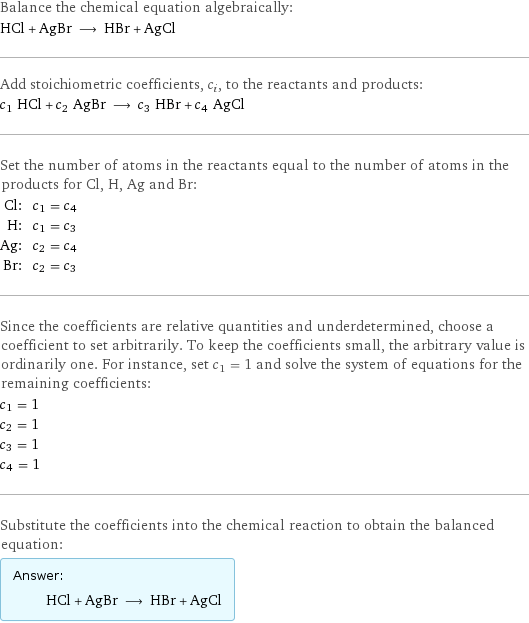
Balance the chemical equation algebraically: HCl + AgBr ⟶ HBr + AgCl Add stoichiometric coefficients, c_i, to the reactants and products: c_1 HCl + c_2 AgBr ⟶ c_3 HBr + c_4 AgCl Set the number of atoms in the reactants equal to the number of atoms in the products for Cl, H, Ag and Br: Cl: | c_1 = c_4 H: | c_1 = c_3 Ag: | c_2 = c_4 Br: | c_2 = c_3 Since the coefficients are relative quantities and underdetermined, choose a coefficient to set arbitrarily. To keep the coefficients small, the arbitrary value is ordinarily one. For instance, set c_1 = 1 and solve the system of equations for the remaining coefficients: c_1 = 1 c_2 = 1 c_3 = 1 c_4 = 1 Substitute the coefficients into the chemical reaction to obtain the balanced equation: Answer: | | HCl + AgBr ⟶ HBr + AgCl
Structures

+ ⟶ +
Names

hydrogen chloride + silver bromide ⟶ hydrogen bromide + silver chloride
Reaction thermodynamics
Enthalpy
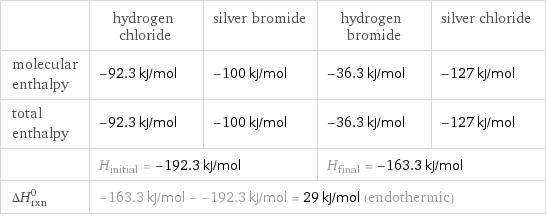
| hydrogen chloride | silver bromide | hydrogen bromide | silver chloride molecular enthalpy | -92.3 kJ/mol | -100 kJ/mol | -36.3 kJ/mol | -127 kJ/mol total enthalpy | -92.3 kJ/mol | -100 kJ/mol | -36.3 kJ/mol | -127 kJ/mol | H_initial = -192.3 kJ/mol | | H_final = -163.3 kJ/mol | ΔH_rxn^0 | -163.3 kJ/mol - -192.3 kJ/mol = 29 kJ/mol (endothermic) | | |
Gibbs free energy
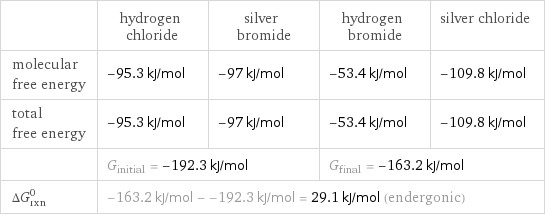
| hydrogen chloride | silver bromide | hydrogen bromide | silver chloride molecular free energy | -95.3 kJ/mol | -97 kJ/mol | -53.4 kJ/mol | -109.8 kJ/mol total free energy | -95.3 kJ/mol | -97 kJ/mol | -53.4 kJ/mol | -109.8 kJ/mol | G_initial = -192.3 kJ/mol | | G_final = -163.2 kJ/mol | ΔG_rxn^0 | -163.2 kJ/mol - -192.3 kJ/mol = 29.1 kJ/mol (endergonic) | | |
Entropy
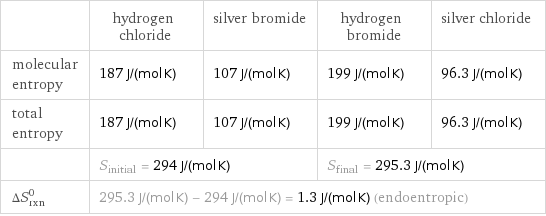
| hydrogen chloride | silver bromide | hydrogen bromide | silver chloride molecular entropy | 187 J/(mol K) | 107 J/(mol K) | 199 J/(mol K) | 96.3 J/(mol K) total entropy | 187 J/(mol K) | 107 J/(mol K) | 199 J/(mol K) | 96.3 J/(mol K) | S_initial = 294 J/(mol K) | | S_final = 295.3 J/(mol K) | ΔS_rxn^0 | 295.3 J/(mol K) - 294 J/(mol K) = 1.3 J/(mol K) (endoentropic) | | |
Equilibrium constant
![Construct the equilibrium constant, K, expression for: HCl + AgBr ⟶ HBr + AgCl Plan: • Balance the chemical equation. • Determine the stoichiometric numbers. • Assemble the activity expression for each chemical species. • Use the activity expressions to build the equilibrium constant expression. Write the balanced chemical equation: HCl + AgBr ⟶ HBr + AgCl Assign stoichiometric numbers, ν_i, using the stoichiometric coefficients, c_i, from the balanced chemical equation in the following manner: ν_i = -c_i for reactants and ν_i = c_i for products: chemical species | c_i | ν_i HCl | 1 | -1 AgBr | 1 | -1 HBr | 1 | 1 AgCl | 1 | 1 Assemble the activity expressions accounting for the state of matter and ν_i: chemical species | c_i | ν_i | activity expression HCl | 1 | -1 | ([HCl])^(-1) AgBr | 1 | -1 | ([AgBr])^(-1) HBr | 1 | 1 | [HBr] AgCl | 1 | 1 | [AgCl] The equilibrium constant symbol in the concentration basis is: K_c Mulitply the activity expressions to arrive at the K_c expression: Answer: | | K_c = ([HCl])^(-1) ([AgBr])^(-1) [HBr] [AgCl] = ([HBr] [AgCl])/([HCl] [AgBr])](../image_source/94419dc9eeff01e1779216daf9d1ff5f.png)
Construct the equilibrium constant, K, expression for: HCl + AgBr ⟶ HBr + AgCl Plan: • Balance the chemical equation. • Determine the stoichiometric numbers. • Assemble the activity expression for each chemical species. • Use the activity expressions to build the equilibrium constant expression. Write the balanced chemical equation: HCl + AgBr ⟶ HBr + AgCl Assign stoichiometric numbers, ν_i, using the stoichiometric coefficients, c_i, from the balanced chemical equation in the following manner: ν_i = -c_i for reactants and ν_i = c_i for products: chemical species | c_i | ν_i HCl | 1 | -1 AgBr | 1 | -1 HBr | 1 | 1 AgCl | 1 | 1 Assemble the activity expressions accounting for the state of matter and ν_i: chemical species | c_i | ν_i | activity expression HCl | 1 | -1 | ([HCl])^(-1) AgBr | 1 | -1 | ([AgBr])^(-1) HBr | 1 | 1 | [HBr] AgCl | 1 | 1 | [AgCl] The equilibrium constant symbol in the concentration basis is: K_c Mulitply the activity expressions to arrive at the K_c expression: Answer: | | K_c = ([HCl])^(-1) ([AgBr])^(-1) [HBr] [AgCl] = ([HBr] [AgCl])/([HCl] [AgBr])
Rate of reaction
![Construct the rate of reaction expression for: HCl + AgBr ⟶ HBr + AgCl Plan: • Balance the chemical equation. • Determine the stoichiometric numbers. • Assemble the rate term for each chemical species. • Write the rate of reaction expression. Write the balanced chemical equation: HCl + AgBr ⟶ HBr + AgCl Assign stoichiometric numbers, ν_i, using the stoichiometric coefficients, c_i, from the balanced chemical equation in the following manner: ν_i = -c_i for reactants and ν_i = c_i for products: chemical species | c_i | ν_i HCl | 1 | -1 AgBr | 1 | -1 HBr | 1 | 1 AgCl | 1 | 1 The rate term for each chemical species, B_i, is 1/ν_i(Δ[B_i])/(Δt) where [B_i] is the amount concentration and t is time: chemical species | c_i | ν_i | rate term HCl | 1 | -1 | -(Δ[HCl])/(Δt) AgBr | 1 | -1 | -(Δ[AgBr])/(Δt) HBr | 1 | 1 | (Δ[HBr])/(Δt) AgCl | 1 | 1 | (Δ[AgCl])/(Δt) (for infinitesimal rate of change, replace Δ with d) Set the rate terms equal to each other to arrive at the rate expression: Answer: | | rate = -(Δ[HCl])/(Δt) = -(Δ[AgBr])/(Δt) = (Δ[HBr])/(Δt) = (Δ[AgCl])/(Δt) (assuming constant volume and no accumulation of intermediates or side products)](../image_source/0b3d3ba8aeeb73e0f3b8b14402b5ec74.png)
Construct the rate of reaction expression for: HCl + AgBr ⟶ HBr + AgCl Plan: • Balance the chemical equation. • Determine the stoichiometric numbers. • Assemble the rate term for each chemical species. • Write the rate of reaction expression. Write the balanced chemical equation: HCl + AgBr ⟶ HBr + AgCl Assign stoichiometric numbers, ν_i, using the stoichiometric coefficients, c_i, from the balanced chemical equation in the following manner: ν_i = -c_i for reactants and ν_i = c_i for products: chemical species | c_i | ν_i HCl | 1 | -1 AgBr | 1 | -1 HBr | 1 | 1 AgCl | 1 | 1 The rate term for each chemical species, B_i, is 1/ν_i(Δ[B_i])/(Δt) where [B_i] is the amount concentration and t is time: chemical species | c_i | ν_i | rate term HCl | 1 | -1 | -(Δ[HCl])/(Δt) AgBr | 1 | -1 | -(Δ[AgBr])/(Δt) HBr | 1 | 1 | (Δ[HBr])/(Δt) AgCl | 1 | 1 | (Δ[AgCl])/(Δt) (for infinitesimal rate of change, replace Δ with d) Set the rate terms equal to each other to arrive at the rate expression: Answer: | | rate = -(Δ[HCl])/(Δt) = -(Δ[AgBr])/(Δt) = (Δ[HBr])/(Δt) = (Δ[AgCl])/(Δt) (assuming constant volume and no accumulation of intermediates or side products)
Chemical names and formulas
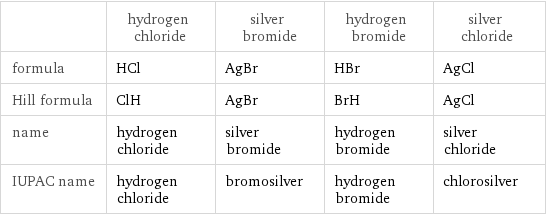
| hydrogen chloride | silver bromide | hydrogen bromide | silver chloride formula | HCl | AgBr | HBr | AgCl Hill formula | ClH | AgBr | BrH | AgCl name | hydrogen chloride | silver bromide | hydrogen bromide | silver chloride IUPAC name | hydrogen chloride | bromosilver | hydrogen bromide | chlorosilver
Substance properties

| hydrogen chloride | silver bromide | hydrogen bromide | silver chloride molar mass | 36.46 g/mol | 187.77 g/mol | 80.912 g/mol | 143.32 g/mol phase | gas (at STP) | solid (at STP) | gas (at STP) | solid (at STP) melting point | -114.17 °C | 432 °C | -86.8 °C | 455 °C boiling point | -85 °C | 1300 °C | -66.38 °C | 1554 °C density | 0.00149 g/cm^3 (at 25 °C) | 6.473 g/cm^3 | 0.003307 g/cm^3 (at 25 °C) | 5.56 g/cm^3 solubility in water | miscible | insoluble | miscible | surface tension | | | 0.0271 N/m | dynamic viscosity | | | 8.4×10^-4 Pa s (at -75 °C) |
Units
